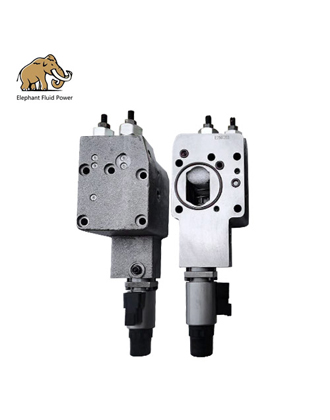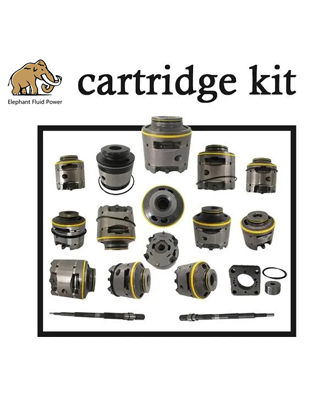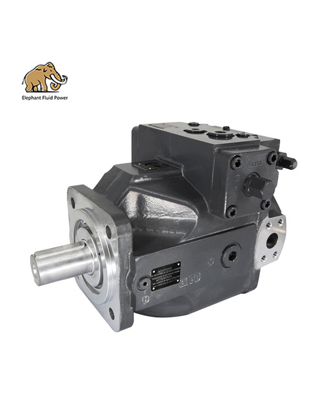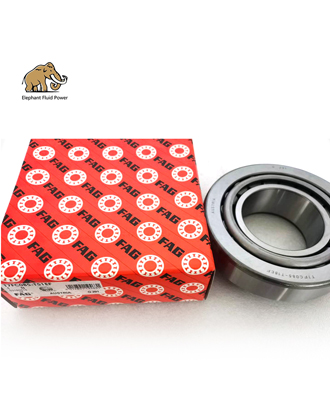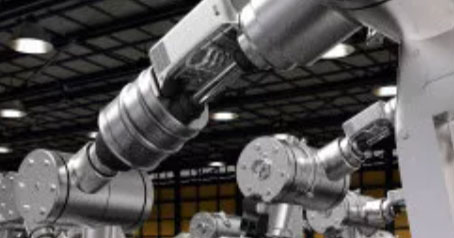Common troubleshooting
1. Piston Pump output flow is insufficient or does not output oil
(1) Insufficient intake. The reason is that the resistance on the suction line is too large or the oil supplement is insufficient. For example, the speed of Piston Pump is too high, the liquid level in the fuel tank is too low, the oil inlet pipe is leaking, and the oil filter is blocked.
(2) The leakage is too large. The reason is that the gap of Piston Pump is too large and the sealing is not good. If the oil distribution plate is scratched by metal fragments, iron filings, etc., the end surface is leaking oil; the sealing surface of the one-way valve in the variable mechanism is not well matched, and the bearing surface of the Piston Pump body and the oil distribution plate has blisters or scratches. The damaged part of the pump can be judged by checking the foreign matter mixed in the hydraulic oil in the pump body.
(3) The tilt angle of the swash plate is too small, and the displacement of the Piston Pump is small. This requires adjusting the variable piston to increase the tilt angle of the swash plate.
2. The oil displacement is not zero at the neutral position
When the inclination of the swash plate of the variable axial Piston Pump is zero, it is called the neutral position. At this time, the output flow of the Piston Pump should be zero. However, sometimes the midpoint deviates from the midpoint of the adjustment mechanism, and there is still flow output at the midpoint. The reason is that the position of the controller is deviated, loose or damaged, and needs to be re-zeroed, tightened or replaced. Piston Pump's angle maintenance is not enough, and the tilt angle trunnion is worn out.
3. Output flow fluctuation
The output flow fluctuation is related to many factors. The variable Piston Pump can be considered to be caused by the poor control of the variable mechanism, such as foreign matter entering the variable mechanism, marking step marks, abrasion marks, scars, etc. on the control Piston, resulting in unstable movement of the control piston. Due to insufficient amplifier energy, damaged parts, and poor performance of the Piston control damper containing springs, the motion of the Piston control will be unstable. Unstable flow is often accompanied by pressure fluctuations. Such failures generally require disassembling Piston Pump, replacing damaged parts, increasing damping, increasing spring stiffness and control pressure.
4. Abnormal output pressure
The output pressure of the pump is determined by the load and is approximately proportional to the input torque. There are two types of faults for abnormal output pressure.
(1) The output pressure is too low
When Piston Pump is in the self-priming state, if the oil inlet pipe leaks or there is a large leak in the hydraulic cylinder, one-way valve, reversing valve, etc. in the system, the pressure will not rise. This requires finding out where the air is leaking, tightening and replacing the seals to increase the pressure. If the overflow valve is faulty or the adjustment pressure is low, and the system pressure cannot rise, the pressure should be re-adjusted or the overflow valve should be overhauled. If the cylinder body of the hydraulic pump and the valve plate have a large amount of leakage, and the cylinder body may be broken in severe cases, the mating surface should be reground or the Piston Pump should be replaced.
(2) The output pressure is too high
If the circuit load continues to rise, the pump pressure also continues to rise, which is normal. If the load is constant and the pressure of Piston Pump exceeds the pressure required by the load, check hydraulic components other than Piston Pump, such as directional valves, pressure valves, transmissions and oil return pipelines. If the maximum pressure is too high, the relief valve should be adjusted.
5. Vibration and noise
Vibration and noise occur at the same time. They not only cause harm to the operator of the machine, but also cause pollution to the environment.
(1) Mechanical vibration and noise
For example, Piston Pump shaft and motor shaft are not concentric or top dead, the bearings and couplings of the rotating shaft are damaged, the elastic cushion is damaged, and the assembly bolts are loosened will cause noise. For pumps that operate at high speeds or transmit large energy, check regularly and record the amplitude, frequency and noise of each component. If the rotation frequency of the pump is the same as the natural frequency of the pressure valve, resonance will be caused. The rotation speed of Piston Pump can be changed to eliminate resonance.
(2) The noise generated by the liquid flow in the pipeline
The oil inlet pipe is too thin, the flow capacity of the oil inlet filter is too small or blocked, the oil inlet pipe sucks in air, the oil is too high, the oil level is too low, the oil suction is insufficient, and the high-pressure pipe produces liquid hammer, etc., all of which will produce noise. Therefore, the fuel tank must be designed correctly, and the oil filter, oil pipe and directional valve must be correctly selected.
6. Hydraulic Piston Pump overheated
There are two reasons for the excessive heating of the hydraulic pump. One is the heat generated by mechanical friction. Since the moving surface is in a state of dry friction or semi-dry friction, the moving parts rub against each other to generate heat. The second is heat generated by liquid friction. The high-pressure oil leaks into the low-pressure cavity through various gaps, and a large amount of hydraulic energy is lost to heat energy. Therefore, the correct selection of the gap between the moving parts, the oil tank volume and the cooler can prevent the Piston Pump from overheating and overheating of the oil. In addition, the clogging of the oil return filter causes excessive oil return back pressure, which can also cause excessive oil temperature and overheating of the Piston Pump body.
7. Oil spill
Piston Pump oil leakage is mainly due to the following reasons: (1) The main shaft oil seal is damaged or the shaft is defective or scratched; (2) The internal leakage is too large, which causes the pressure at the oil seal to increase, and the oil seal is damaged or rushed out; (3) Leakage The tubing is too thin and long, causing oil leakage at the seal; (4) Piston Pump's external tubing is loose, pipe joints are damaged, gaskets are aged or cracked; (5) Variable adjustment mechanism bolts are loose, and the seal is damaged; (6) Piston Pump cast iron The shell has blisters or poor welding.
Nowadays, there are many manufacturers of Piston Pump. The structure of imported parts and domestic parts are different. Each Piston Pump should be used strictly in accordance with its factory instructions. When repairing Piston Pump, you should first check whether the Piston Pump is properly installed and used in the system, so as to find out the cause of damage in time, eliminate hidden dangers, and ensure the normal operation of the system. The repaired Piston Pump can only be used after passing certain testing equipment. If the test conditions are not available, the system should be debugged repeatedly to make it work normally.
If you need a piston pump diagram, please contact Elephant Fluid Power, our company's full range of piston pump diagrams, look forward to your consultation
 French
French
 Portuguese
Portuguese
 Russian
Russian
 German
German
 Spanish
Spanish
 Japanese
Japanese
 Korean
Korean
 Irish
Irish
 Greek
Greek
 Turkish
Turkish
 Italian
Italian
 Danish
Danish
 Romanian
Romanian
 Indonesian
Indonesian
 Czech
Czech
 Afrikaans
Afrikaans
 Swedish
Swedish
 Polish
Polish
 Basque
Basque
 Catalan
Catalan
 Esperanto
Esperanto
 Hindi
Hindi
 Lao
Lao
 Albanian
Albanian
 Amharic
Amharic
 Armenian
Armenian
 Azerbaijani
Azerbaijani
 Belarusian
Belarusian
 Bengali
Bengali
 Bosnian
Bosnian
 Bulgarian
Bulgarian
 Cebuano
Cebuano
 Chichewa
Chichewa
 Corsican
Corsican
 Croatian
Croatian
 Dutch
Dutch
 Estonian
Estonian
 Filipino
Filipino
 Finnish
Finnish
 Frisian
Frisian
 Galician
Galician
 Georgian
Georgian
 Gujarati
Gujarati
 Haitian
Haitian
 Hausa
Hausa
 Hawaiian
Hawaiian
 Hebrew
Hebrew
 Hmong
Hmong
 Hungarian
Hungarian
 Icelandic
Icelandic
 Igbo
Igbo
 Javanese
Javanese
 Kannada
Kannada
 Kazakh
Kazakh
 Khmer
Khmer
 Kurdish
Kurdish
 Kyrgyz
Kyrgyz
 Latin
Latin
 Latvian
Latvian
 Lithuanian
Lithuanian
 Luxembourg
Luxembourg
 Macedoniar
Macedoniar
 Malagasy
Malagasy
 Malay
Malay
 Malayalam
Malayalam
 Maltese
Maltese
 Maori
Maori
 Marathi
Marathi
 Mongolian
Mongolian
 Burmese
Burmese
 Nepali
Nepali
 Norwegian
Norwegian
 Pashto
Pashto
 Persian
Persian
 Punjabi
Punjabi
 Serbian
Serbian
 Sesotho
Sesotho
 Sinhala
Sinhala
 Slovak
Slovak
 Slovenian
Slovenian
 Somali
Somali
 Samoan
Samoan
 Scots Gaelic
Scots Gaelic
 Shona
Shona
 Sindhi
Sindhi
 Sundanese
Sundanese
 Swahili
Swahili
 Tajik
Tajik
 Tamil
Tamil
 Telugu
Telugu
 Thai
Thai
 Ukrainian
Ukrainian
 Urdu
Urdu
 Uzbek
Uzbek
 Vietnamese
Vietnamese
 Welsh
Welsh
 Xhosa
Xhosa
 Yiddish
Yiddish
 Yoruba
Yoruba
 Zulu
Zulu

